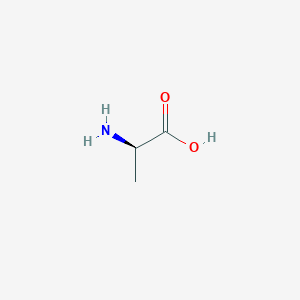| General Information of MET (ID: META00406) |
| Name |
D-Alanine
|
| Synonyms |
Click to Show/Hide Synonyms of This Metabolite
(2R)-2-Aminopropanoate; (2R)-2-Aminopropanoic acid; (2R)-2-Aminopropionic acid; (R)-2-Aminopropanoate; (R)-2-Aminopropanoic acid; (R)-Alanine; Alanine; D(-)-a -Alanine; D(-)-alpha-Alanine; D-(-)-Alanine; D-2-Aminopropionate; D-2-Aminopropionic acid; D-Ala; D-Alanin; D-a-Aminopropionate; D-a-Aminopropionic acid; D-alpha-Alanine; D-alpha-Aminopropionic acid; DAL
|
| Source |
Endogenous;Escherichia Coli Metabolite;Yeast Metabolite;Food;Microbial
|
| Structure Type |
Amino acids, peptides, and analogues (Click to Show/Hide the Complete Structure Type Hierarchy)
Organic acids and derivatives
Carboxylic acids and derivatives
Amino acids, peptides, and analogues
|
| PubChem CID |
|
| HMDB ID |
|
| Formula |
C3H7NO2
|
| Structure |
<iframe style="width: 300px; height: 300px;" frameborder="0" src="https://embed.molview.org/v1/?mode=balls&cid=71080"></iframe>
|
 |
|
3D MOL
|
2D MOL
|
|
Click to Show/Hide the Molecular/Functional Data (External Links/Property/Function) of This Metabolite
|
| KEGG ID |
|
| DrugBank ID |
|
| ChEBI ID |
|
| FooDB ID |
|
| ChemSpider ID |
|
| Physicochemical Properties |
Molecular Weight |
89.09 |
Topological Polar Surface Area |
63.3 |
| XlogP |
-3 |
Complexity |
61.8 |
| Heavy Atom Count |
6 |
Rotatable Bond Count |
1 |
| Hydrogen Bond Donor Count |
2 |
Hydrogen Bond Acceptor Count |
3 |
| Function |
Alanine is a nonessential amino acid made in the body from the conversion of the carbohydrate pyruvate or the breakdown of DNA and the dipeptides carnosine and anserine. It is highly concentrated in muscle and is one of the most important amino acids released by muscle, functioning as a major energy source. Plasma alanine is often decreased when the BCAA (Branched Chain Amino Acids) are deficient. This finding may relate to muscle metabolism. Alanine is highly concentrated in meat products and other high-protein foods like wheat germ and cottage cheese. Alanine is an important participant as well as regulator in glucose metabolism. Alanine levels parallel blood sugar levels in both diabetes and hypoglycemia, and alanine reduces both severe hypoglycemia and the ketosis of diabetes. It is an important amino acid for lymphocyte reproduction and immunity. Alanine therapy has helped dissolve kidney stones in experimental animals. Normal alanine metabolism, like that of other amino acids, is highly dependent upon enzymes that contain vitamin B6. Alanine, like GABA, taurine and glycine, is an inhibitory neurotransmitter in the brain. http://www.dcnutrition.com/AminoAcids/). Alanine can be found in some Gram-positive bacteria.
|
|
Regulatory Network
|
|
|
|
|
|
|
|
|
 click to show the details of this protein
click to show the details of this protein
 click to show the details of experiment for validating this pair
click to show the details of experiment for validating this pair

